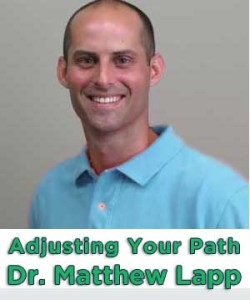It takes thought, planning and maybe even some changes to live a healthy life
By Dr. Matthew Lapp, MS, DC, Columnist, The Times
 If you aren’t sick, does that mean you’re healthy? How about if you aren’t depressed? Does that mean you’re happy? For most people, the answer to these questions would be “no.” However, how often do we base our state of health on symptoms, or lack thereof?
If you aren’t sick, does that mean you’re healthy? How about if you aren’t depressed? Does that mean you’re happy? For most people, the answer to these questions would be “no.” However, how often do we base our state of health on symptoms, or lack thereof?
Our current healthcare system is a perfect example. The goal is usually to eliminate symptoms of disease, and we spend a lot of money to do it. According to the Centers for Medicare & Medicaid Services, in 2010 total healthcare expenditures in the US reached $2.6 trillion (that’s 12 zeros in case you’re keeping track.) That comes out to over $8,000 per person. This health paradigm suggests that we reduce the fever, dull the pain, pop that pill and go on with our lives. But in the long run, do these passive behaviors actually lead us toward greater health? In essence, our healthcare system advocates quantity of life, not necessarily quality of life.
I think that we’ve got it backwards. If the goal is to achieve health, lets study and promote behaviors and perceptions that promote health. Lets put structures in place that allow health to flourish. And, if the goal is to achieve optimal health we need to go even further. We have no way of knowing the capacities of human functioning or the possibilities that exist with regard to health and happiness. Enter wellness.
It’s probably a term that you’re familiar with, or have at least heard mention of at your local drug store or minute clinic. It’s the topic of many conversations, magazine articles, and television commercials and it’s a billion dollar industry. The problem is that its an often used, but rarely understood term. Many insurance programs now offer “wellness incentives” and almost all pharmacies offer in-store discounts for joining their respective “wellness programs.” These organizations would have us believe that achieving wellness is as simple as taking our medication du jour and getting a once a year check-up.
More accurately, Charles B. Corbin from Arizona State University defines wellness as a “multidimensional state of being describing the existence of positive health in an individual as exemplified by quality of life and a sense of well-being.”
The key concept of this definition is that that many factors influence a person’s individual state of wellness. Some of those factors that may influence a person’s overall level of well-being are physical, mental, emotion, financial, spiritual, environmental, and social health. Another truth is that wellness is an active state of being which exists on a limitless continuum. It’s up to us as individuals to claim ownership of that state regardless of our life circumstances. By doing so, we become empowered to take responsibility for our own health and well-being.
At this point, you might have questions about where you stand. So, if you’re new to the wellness game, here are a few simple steps to get you started on your path to well-being. First, grab a piece of paper and draw a large circle. Next, draw eight lines starting in the center of the circle and extending to the edges of the circle. Each line represents a different area of life and completes the circle like spokes on a wheel. Label these lines: physical, mental, emotional, social, spiritual, financial, career, and environmental. Next, give yourself a score in each category by making a mark along the line. The closer the mark is to the center of the circle the lower the score. The farther away from the middle, the higher the score. A perfect score would fall directly on the boarder of the large circle you started with. Finally, connect the dots. When your examine your own “well-being wheel,” what do you see? Is the ride bumpy or smooth? Just as a single flat tire can make the whole car ride uncomfortable, an area of life that you’ve been ignoring could be detrimental to your quality of life.
That also means that we should celebrate those areas of life where we’re successful! Whether we’re happy with the results or not, we can take solace in knowing that we ultimately have the power to influence the results. That doesn’t mean that we should shun modern medicine or ignore signs of disease, it simply means that in order for us to move towards higher levels of optimal health and wellness, we need to take a more active role in our healthcare. It means that, as a nation, we might need to reconsider our healthcare goals. There’s no superhero waiting to rescue us. We don’t get do-overs. We should all embrace the power that is within us and strive to create the best possible lives that we can.
Matthew Lapp, MS, DC is the owner of Salus Chiropractic Studio in Thorndale. For more information, visit him on Facebook at http://www.facebook.com/SalusChiropracticStudio.







Trackbacks